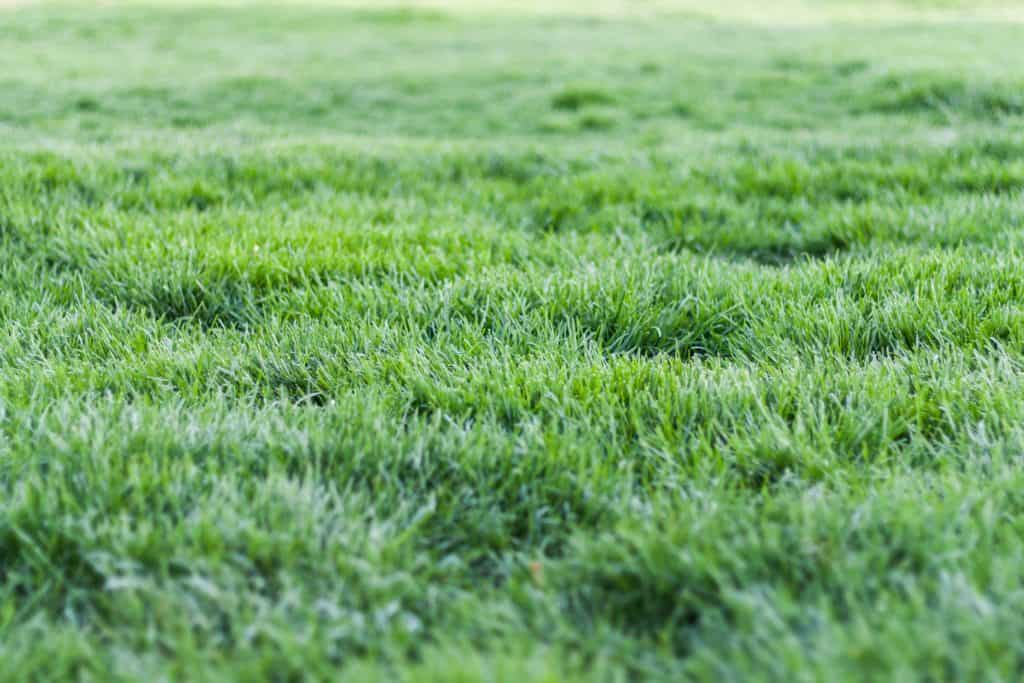A lawn renovation is one of those tasks that you want to get right the first time. We say this because it is often costly and the labor time can be significant.
Keep in mind that a lawn renovation differs from a lawn replacement. A lawn renovation works with the existing grass to attempt to create a healthier and greener lawn. It is designed for lawns that are primarily grass and are not overrun by weeds.
A lawn replacement kills off the existing lawn and weeds with a product such as Roundup Grass Killer. New sod or seed can then be spread or rolled out a few days later as advised by the manufacturer. A lawn replacement is a good option for a lawn that is mostly weeds and/or has undesirable grass growing.
Below we have provided 12 steps to help improve your chances of lawn renovation success. Most of these steps also apply to a total lawn replacement.
Table of Contents
Lawn Renovation: The 12 Steps for a Peak Lawn
- Plan – The best time to complete a lawn renovation is early fall when soil temperatures are ideal for lawn growth for cool-season lawns. Secondarly, spring is also an option but weeds and the unpredictable weather can cause problems during this time. Late spring to early summer is typically the best time for southern warm-season lawns.
- Soil Test – We recommend obtaining a lawn soil test before beginning a renovation. A good soil test can provide vital information about what a lawn is lacking in terms nutrients. We recommend the Soil Savy Soil Test Kit. This kit comes with a jar that you fill with lawn soil. You then send this jar to the test lab in the provided prepaid envelope. After about 7-10 days, the results will be ready to be reviewed online. These results will provide information on the level of 14 nutrients and the lawn’s pH level. The manufacturer also supplies a list of product recommendations in your area, such as fertilizers, to improve your lawn’s health.
- Mow Low – Mow the lawn low (not scalped) and bag the clippings if your mower allows this option. When the lawn is overseeded in a later step, this will allow it to receive sunlight and the water necessary for growth.
- Clean up Debris – The lawn should be given a solid raking to clean up debris and remove dead grass. This raking will also help losing up the lawn soil in preparation for overseeding.
- Aeration – We recommend renting a core aerator machine from a local tool rental or hardware store. You may also consider hiring this work out because operating the machine can be laborious. The aerator pulls cores of soil from the lawn. This allows air, water, and nutrients to better penetrate down to the grass roots. It also helps uncompact the soil to help the roots grow deeper. Many people skip this step, but it is one of the keys to a healthier lawn. Aerating by hand is an option, but it is not practical unless done on a small yard.
- Fill Holes and Level – Lawn soil should be spread into holes and uneven areas should be flattened out. You should also spread a layer of soil into bare spots so that the seed has a solid base to grow from.
- Overseed – Overseeding a lawn is completed by spreading grass seed over the existing lawn. You can use a spreader, like the one you use for fertilizer, to spread the seed. This grass seed grows in between the existing grass blades to create a thicker lawn. Use a high-quality grass seed and plant the seed in fall for the best results. Common cool-season (northern) grasses include Kentucky bluegrass, turf-type tall fescue, perennial ryegrass, and fine fescue. Warm-season grasses (southern) include bahia, centipede, bermuda, St. Augustine, and zoysia.
- Starter Fertilizer – Spread a starter fertilizer over the lawn that you just overseeded, such as Scott’s Turf Builder Starter Food. Apply the fertilizer at the rate recommended by the manufacturer. This will help your lawn grow thicker and quicker by supplying the seeds with essential nutrients. Be sure to only use a starter fertilizer since other fertilizers (i.e. weed and feed fertilizer) may potentially kill the seeds and do not necessarily has the correct nutrients for promoting seed growth. Read the fertilizer bag to verify the seed can be used on new grass.
- Water – Watering new grass seed is vital for success. Water twice a day (morning and evening) for 10 minutes each watering until the grass blades have grown 2 inches. You can then cut back on the watering to the normal 1 inch per week. Watering should be adjusted based on the rain or lack thereof.
- Mow High – Once the grass seed has reached mowing height, you can then mow. Only remove 1/3 or less of the grass blades in one mowing session. Keep in mind that a lawn that is mowed tall will help the soil retain water and shade out weeds. See our article on how often to cut grass to determine the height to mow your type of grass. We recommend investing in a lawn mower blade sharpener so that your mower will consistently provide a healthy cut of the grass blades. A dull blade will tear the blades, which can results in numerous lawn problems such as fungus and diseases.
- Fertilizer – Approximately 5 to 8 weeks after the seed has germinated, fertilizer should be applied. We recommend a product such as Scott’s Green Max, which has a solid level of nitrogen with no phosphorus. The phosphorus your lawn obtain from the starter fertilizer in step 8 above is enough.
- Weed Control – Once your seed has fully developed into a lush lawn, it is time to start controlling any remaining weeds. We recommend spot spraying weeds with a weed control product that handles most types of weeds. Better yet, manually pull them out down to the root. We love the Fiskars Claw Weeder for this task. Wait until the lawn has been mowed four times after new seed growth before controlling weeds.
Conclusion
At the end of the above steps, your lawn should be looking remarkably better. Hopefully it will be the best in your neighborhood. Be sure to monitor your lawn and immediately take care of the numerous problems that pop up in even the most pristine lawns (weeds, grubs, ect.). While the above steps are costly and time consuming as a whole, completing these steps will put you on a path for future success with less overall maintenance and money spent trying to fix burdensome lawn problems.

